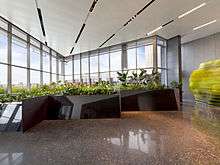Living machine
Living Machine is a form of ecological sewage treatment.[1] Similar to Solar Aquatics Systems,[2] the latest generation of the technology is based on fixed-film ecology.[3][4]

The Living Machine system was commercialized and is marketed by Living Machine Systems, L3C, a corporation based in Charlottesville, Va.
Design theory
The powerful paradigm of regarding microorganisms as living machines is far fetching and has inspired, respectively is overlapping, with countless applications in other fields. Examples are mechanical composters for industrial kitchens, effective microorganisms as fertiliser for agricultural purposes and Integrated Biotectural systems in landscaping and architecture like Earthships or the IBTS Greenhouse.
Components like tomato plants for more water purification and fish for food have been part of the living, ecosystem-like designs. The Design theory is not limited to any size of the system, or the amount of species. One design optimum is a natural ecosystem which is designed for a special purpose like a sewage treating wetland in a suitable ecosystem for the locality. Another optimum is an economically viable system returning profit for the investor. The practice of Permaculture is one example for a compromise between the two optimum design points.
Examples
The scale of Living Machine systems ranges from the individual building to community-scale public works. Some of the earliest Living Machines were used to treat domestic wastewater in small, ecologically-conscious villages, such as Findhorn Community in Scotland,.[5] Some treated the mixed municipal wastewater for semi-urban areas, such as South Burlington, Vermont (this plant is closed).[6] The latest-generation Tidal Flow Wetland Living Machines are being used in major urban office buildings, military bases, housing developments, resorts and institutional campuses.[7]
Living Machine System Process
- “Fixed film ecology” has superseded systems based on hydroponics or a fluid medium. In fixed film systems the wetland cells are filled with a solid aggregate medium having extensive surface area for beneficial biofilm (treatment bacteria) growth. Fixed film ecology allows denser and more diverse micro-ecosystems to form than does a liquid medium. These ecosystems go well beyond bacteria to include a variety of organisms up to and including macro-vegetation.
- Tidal cycles (filling and draining the wetland in accelerated tidal action, with 12 or more cycles per day) are used to passively bring oxygen into the wetland cells. This action mimics the type of biological action that occurs in natural tidal estuaries. Tidal flow wetlands replace the need to blow air into a liquid medium -- they use gravity to bring atmospheric oxygen into the cell when it is drained.
See also
- Bioremediation
- Rain garden
- Anaerobic digestion
- Constructed wetlands
- Biomimicry
- IBTS Greenhouse
References
- "Factsheet: Tidal Wetland Living Machine System -- Description and Scientific Basis." "Archived copy" (PDF). Archived from the original (PDF) on 2011-09-29. Retrieved 2011-08-18.CS1 maint: archived copy as title (link). Retrieved 2011-8-18.
- Maple Reindeers Group. Ontario Science Centre Solar Aquatics System Archived 2013-11-03 at the Wayback Machine.
- "Archived copy". Archived from the original on 2011-11-10. Retrieved 2011-08-18.CS1 maint: archived copy as title (link)
- Water and Waste water Plant Directory. NEB Solar Aquatic System
- Ecovillage Findhorn: Biological Waste Water Treatment Archived 2007-02-10 at the Wayback Machine
- "Archived copy" (PDF). Archived from the original (PDF) on 2006-10-08. Retrieved 2014-01-07.CS1 maint: archived copy as title (link)
- McNair, Dave. "The Tao of Poo: Can Worrell's Green Sewage System Save Water and Planet?" The Hook. June 11, 2009. Retrieved 2011-9-24.